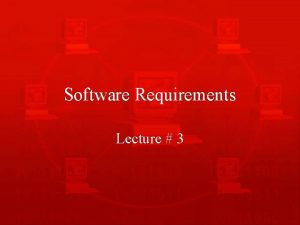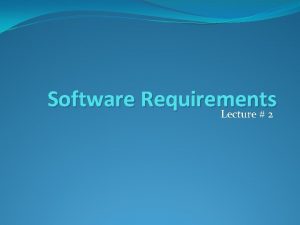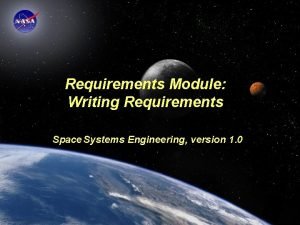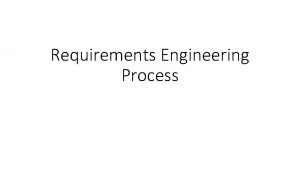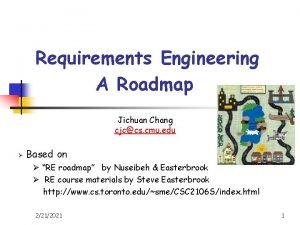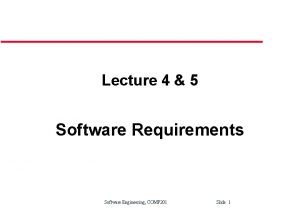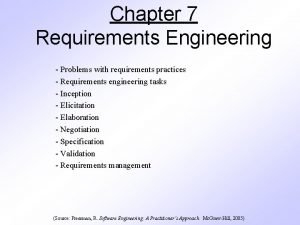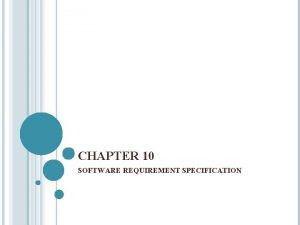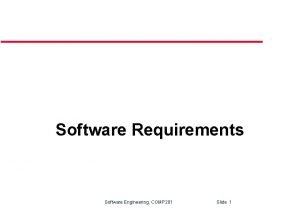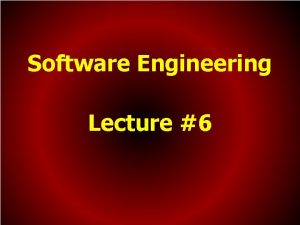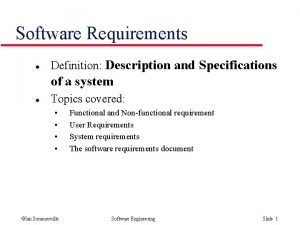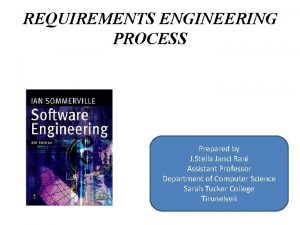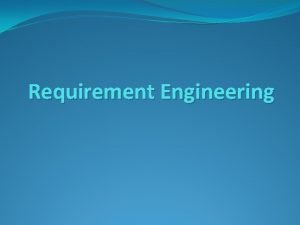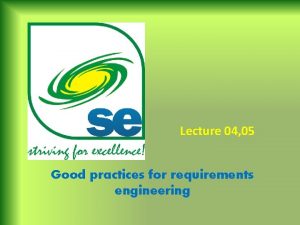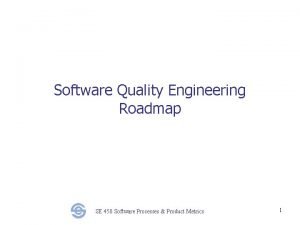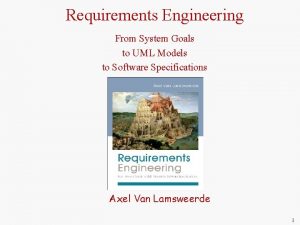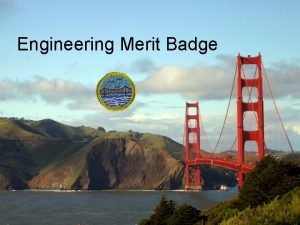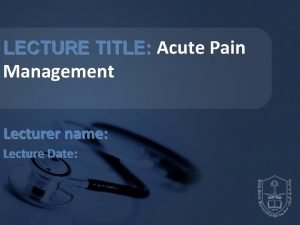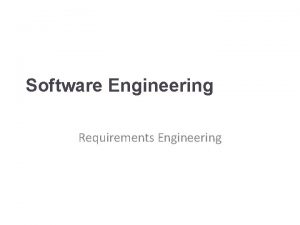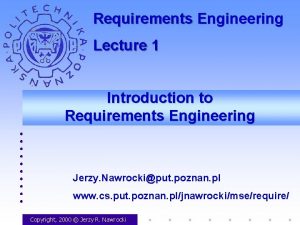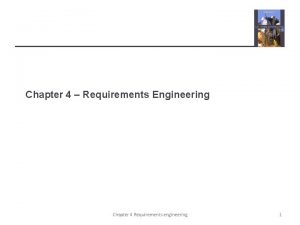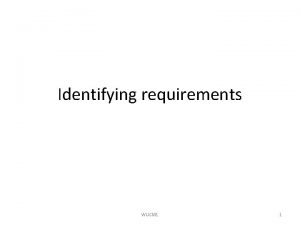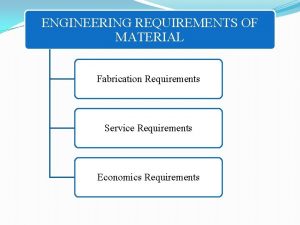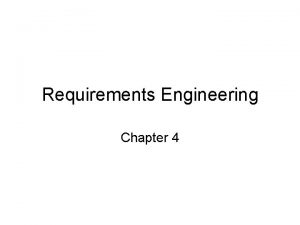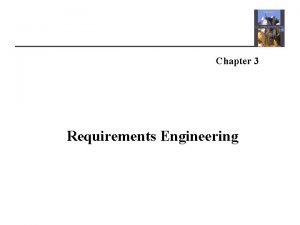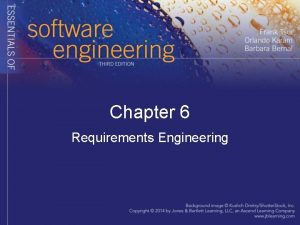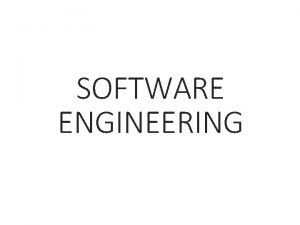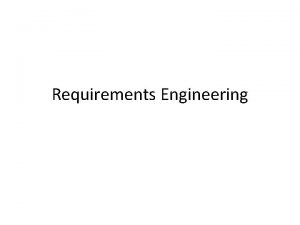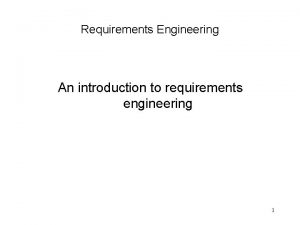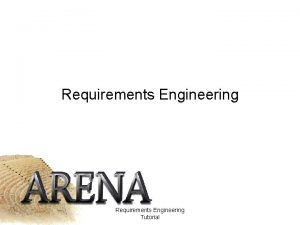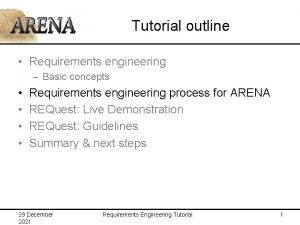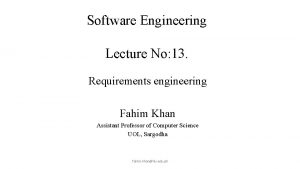Chapter 4 Requirements Engineering Lecture 1 Chapter 4





































































- Slides: 69

Chapter 4 – Requirements Engineering Lecture 1 Chapter 4 Requirements engineering 1

Topics covered ² Functional and non-functional requirements ² The software requirements document ² Requirements specification ² Requirements engineering processes ² Requirements elicitation and analysis ² Requirements validation ² Requirements management Chapter 4 Requirements engineering 2

Requirements engineering ² The process of finding out, analysing, documenting and checking the services and constraints is called “Requirements engineering”. ² The process of establishing the services that the customer requires from a system and the constraints under which it operates and is developed. ² The requirements themselves are the descriptions of the system services and constraints that are generated during the requirements engineering process. Chapter 4 Requirements engineering 3

Types of requirement ² User requirements § Statements in natural language plus diagrams of the services the system provides and its operational constraints. Written for customers. ² System requirements § A structured document setting out detailed descriptions of the system’s functions, services and operational constraints. Defines what should be implemented so may be part of a contract between client and contractor. Chapter 4 Requirements engineering 4

User and system requirements Chapter 4 Requirements engineering 5

Readers of different types of requirements specification Chapter 4 Requirements engineering 6

Functional and non-functional requirements ² Functional requirements § Statements of services the system should provide, how the system should react to particular inputs and how the system should behave in particular situations. § May state what the system should not do. ² Non-functional requirements § Constraints on the services or functions offered by the system such as timing constraints, constraints on the development process, standards, etc. § Often apply to the system as a whole rather than individual features or services. ² Domain requirements § Constraints on the system from the domain of operation Chapter 4 Requirements engineering 7

Functional requirements ² Describe functionality or system services. ² Depend on the type of software, expected users and the type of system where the software is used. ² Functional user requirements may be statements of what the system should do. high-level ² Functional system requirements should describe the system services in detail. Chapter 4 Requirements engineering 8

Example: Functional requirements for the MHC-PMS ² A user shall be able to search the appointments lists for all clinics. ² The system shall generate each day, for each clinic, a list of patients who are expected to attend appointments that day. ² Each staff member using the system shall be uniquely identified by his or her 8 -digit employee number. Chapter 4 Requirements engineering 9

Requirements imprecision ² Problems arise when requirements are not precisely stated. ² Ambiguous requirements may be interpreted in different ways by developers and users. ² Consider the term ‘search’ in requirement 1 § User intention – search for a patient name across all appointments in all clinics; § Developer interpretation – search for a patient name in an individual clinic. User chooses clinic then search. Chapter 4 Requirements engineering 10

Requirements completeness and consistency ² In principle, requirements should be both complete and consistent. ² Complete § They should include descriptions of all facilities required. ² Consistent § There should be no conflicts or contradictions in the descriptions of the system facilities. ² In practice, it is impossible to produce a complete and consistent requirements document. Chapter 4 Requirements engineering 11

Non-functional requirements ² These define system properties and constraints. ² e. g. reliability, response time and storage requirements. Constraints on I/O device capability, system representations, etc. ² Non-functional requirements may be more critical than functional requirements. If these are not met, the system may be useless. Chapter 4 Requirements engineering 12

Types of non-functional requirement Chapter 4 Requirements engineering 13

Non-functional requirements classification ² Product requirements § Requirements which specify how the delivered product must behave in a particular way e. g. execution speed, reliability, etc. ² Organisational requirements § Requirements which are a consequence of organisational policies and procedures e. g. process standards used, implementation requirements, etc. ² External requirements § Requirements which arise from factors which are external to the system and its development process e. g. interoperability requirements, legislative requirements, etc. Chapter 4 Requirements engineering 14

Examples of non-functional requirements in the MHC-PMS Product requirement The MHC-PMS shall be available to all clinics during normal working hours (Mon–Fri, 08. 30– 17. 30). Downtime within normal working hours shall not exceed five seconds in any one day. Organizational requirement Users of the MHC-PMS system shall authenticate themselves using their health authority identity card. External requirement The system shall implement patient privacy provisions as set out in HStan-03 -2006 -priv. Chapter 4 Requirements engineering 15

Metrics for specifying nonfunctional requirements Property Measure Speed Processed transactions/second User/event response time Screen refresh time Size Mbytes Number of ROM chips Ease of use Training time Number of help frames Reliability Mean time to failure Probability of unavailability Rate of failure occurrence Availability Robustness Time to restart after failure Percentage of events causing failure Probability of data corruption on failure Portability Percentage of target dependent statements Number of target systems Chapter 4 Requirements engineering 16

2. The software requirements document ² Also called as “Software Requirement Specification” (SRS). ² The software requirements document is the official statement of what is required of the system developers. ² Should include both a definition of user requirements and a specification of the system requirements. ² It is NOT a design document. As far as possible, it should be a set of WHAT the system should do rather than HOW it should do it. Chapter 4 Requirements engineering 17

Agile methods and requirements ² Many agile methods argue that producing a requirements document is a waste of time as requirements change so quickly. ² The document is therefore always out of date. ² Methods such as Extreme Programming (XP), use incremental requirements engineering and express requirements as ‘user stories’. ² This is practical for business systems but problematic for systems that require a lot of pre-delivery analysis (e. g. critical systems) or systems developed by several teams. Chapter 4 Requirements engineering 18

Users of a requirements document Chapter 4 Requirements engineering 19

The structure of a requirements document Chapter Description Preface This should define the expected readership of the document and describe its version history, including a rationale for the creation of a new version and a summary of the changes made in each version. Introduction This should describe the need for the system. It should briefly describe the system’s functions and explain how it will work with other systems. It should also describe how the system fits into the overall business or strategic objectives of the organization commissioning the software. Glossary This should define the technical terms used in the document. You should not make assumptions about the experience or expertise of the reader. User requirements Here, you describe the services provided for the user. The nonfunctional system definition requirements should also be described in this section. This description may use natural language, diagrams, or other notations that are understandable to customers. Product and process standards that must be followed should be specified. System architecture This chapter should present a high-level overview of the anticipated system architecture, showing the distribution of functions across system modules. Architectural components that are reused should be highlighted. Chapter 4 Requirements engineering 20

The structure of a requirements document Chapter Description System requirements specification This should describe the functional and nonfunctional requirements in more detail. If necessary, further detail may also be added to the nonfunctional requirements. Interfaces to other systems may be defined. System models This might include graphical system models showing the relationships between the system components and the system and its environment. Examples of possible models are object models, data-flow models, or semantic data models. System evolution This should describe the fundamental assumptions on which the system is based, and any anticipated changes due to hardware evolution, changing user needs, and so on. This section is useful for system designers as it may help them avoid design decisions that would constrain likely future changes to the system. Appendices These should provide detailed, specific information that is related to the application being developed; for example, hardware and database descriptions. Hardware requirements define the minimal and optimal configurations for the system. Database requirements define the logical organization of the data used by the system and the relationships between data. Index Several indexes to the document may be included. As well as a normal alphabetic index, there may be an index of diagrams, an index of functions, and so on. Chapter 4 Requirements engineering 21

4. 3 Requirements specification ² The process of writing down the user and system requirements in a requirements document. ² User requirements have to be understandable by endusers and customers who do not have a technical background. ² System requirements are more detailed requirements and may include more technical information. ² The requirements may be part of a contract for the system development § It is therefore important that these are as complete as possible. Chapter 4 Requirements engineering 22

Ways of writing a system requirements specification Notation Description Natural language The requirements are written using numbered sentences in natural language. Each sentence should express one requirement. Structured natural The requirements are written in natural language on a standard form or language template. Each field provides information about an aspect of the requirement. Design description This approach uses a language like a programming language, but with languages more abstract features to specify the requirements by defining an operational model of the system. This approach is now rarely used although it can be useful for interface specifications. Graphical notations Graphical models, supplemented by text annotations, are used to define the functional requirements for the system; UML use case and sequence diagrams are commonly used. Mathematical specifications These notations are based on mathematical concepts such as finite-state machines or sets. Although these unambiguous specifications can reduce the ambiguity in a requirements document, most customers don’t understand a formal specification. They cannot check that it represents what they want and are reluctant to accept it as a system contract Chapter 4 Requirements engineering 23

Requirements and design ² In principle, requirements should state what the system should do and the design should describe how it does this. ² In practice, requirements and design are inseparable. Some of the reasons: § Initial system architecture may be required to frame the requirements. § The system may inter-operate with other systems that generate design requirements; § The use of a specific architecture to satisfy non-functional requirements may be a domain requirement.

Natural language specification ² Requirements are written as natural language sentences supplemented by diagrams and tables. ² Used for writing requirements because it is expressive, intuitive and universal. This means that the requirements can be understood by users and customers. Chapter 4 Requirements engineering 25

Guidelines for writing requirements ² Invent a standard format and use it for all requirements. ² Use language in a consistent way. Use shall for mandatory requirements, should for desirable requirements. ² Use text highlighting to identify key parts of the requirement. ² Avoid the use of computer jargon. ² Include an explanation (rationale) of why a requirement is necessary.

Problems with natural language ² Lack of clarity § Precision is difficult without making the document difficult to read. ² Requirements confusion § Functional and non-functional requirements tend to be mixed-up. ² Requirements amalgamation § Several different requirements may be expressed together.

Example requirements for the insulin pump software system 3. 2 The system shall measure the blood sugar and deliver insulin, if required, every 10 minutes. (Changes in blood sugar are relatively slow so more frequent measurement is unnecessary; less frequent measurement could lead to unnecessarily high sugar levels. ) 3. 6 The system shall run a self-test routine every minute with the conditions to be tested and the associated actions defined in Table 1. (A self-test routine can discover hardware and software problems and alert the user to the fact the normal operation may be impossible. ) Chapter 4 Requirements engineering 28

Structured specifications ² An approach to writing requirements where the freedom of the requirements writer is limited and requirements are written in a standard way. ² This works well for some types of requirements. e. g. requirements for embedded control system but is sometimes too rigid for writing business system requirements. Chapter 4 Requirements engineering 29

A structured specification of a requirement for an insulin pump Chapter 4 Requirements engineering 30

Tabular specification ² Used to supplement natural language. ² Particularly useful when you have to define a number of possible alternative courses of action. ² For example, the insulin pump systems bases its computations on the rate of change of blood sugar level and the tabular specification explains how to calculate the insulin requirement for different scenarios.

Tabular specification of computation for an insulin pump Condition Action Sugar level falling (r 2 < r 1) Comp. Dose = 0 Sugar level stable (r 2 = r 1) Comp. Dose = 0 Sugar level increasing and rate of increase Comp. Dose = 0 decreasing ((r 2 – r 1) < (r 1 – r 0)) Sugar level increasing and rate of increase Comp. Dose = round ((r 2 – r 1)/4) stable or increasing If rounded result = 0 ((r 2 – r 1) ≥ (r 1 – r 0)) then Comp. Dose = Minimum. Dose Chapter 4 Requirements engineering 32

4. Requirements engineering processes ² The processes used for RE vary widely depending on the application domain, the people involved and the organisation developing the requirements. ² However, there a number of generic activities common to all processes § § Requirements elicitation; Requirements analysis; Requirements validation; Requirements management. ² In practice, RE is an iterative activity in which these processes are interleaved. Chapter 4 Requirements engineering 33

A spiral view of the requirements engineering process Chapter 4 Requirements engineering 34

Requirements elicitation and analysis ² Sometimes called requirements elicitation or requirements discovery. ² Involves technical staff working with customers to find out about the application domain, the services that the system should provide and the system’s operational constraints. ² May involve end-users, managers, engineers involved in maintenance, domain experts, trade unions, etc. These are called stakeholders. Chapter 4 Requirements engineering 35

Problems of requirements analysis ² Stakeholders don’t know what they really want. ² Stakeholders express requirements in their own terms. ² Different stakeholders may have conflicting requirements. ² Organisational and political factors may influence the system requirements. ² The requirements change during the analysis process. New stakeholders may emerge and the business environment may change. Chapter 4 Requirements engineering 36

Requirements elicitation and analysis ² Software engineers work with a range of system stakeholders to find out about the application domain, the services that the system should provide, the required system performance, hardware constraints, other systems, etc. ² Stages include: § § Requirements discovery, Requirements classification and organization, Requirements prioritization and negotiation, Requirements specification. Chapter 4 Requirements engineering 37

Therequirements elicitation and analysis process Chapter 4 Requirements engineering 38

Process activities ² Requirements discovery § Interacting with stakeholders to discover their requirements. Domain requirements are also discovered at this stage. ² Requirements classification and organisation § Groups related requirements and organises them into coherent clusters. ² Prioritisation and negotiation § Prioritising requirements and resolving requirements conflicts. ² Requirements specification § Requirements are documented and input into the next round of the spiral.

Problems of requirements elicitation ² Stakeholders don’t know what they really want. ² Stakeholders express requirements in their own terms. ² Different stakeholders may have conflicting requirements. ² Organisational and political factors may influence the system requirements. ² The requirements change during the analysis process. New stakeholders may emerge and the business environment change.

Key points ² The software requirements document is an agreed statement of the system requirements. It should be organized so that both system customers and software developers can use it. ² The requirements engineering process is an iterative process including requirements elicitation, specification and validation. ² Requirements elicitation and analysis is an iterative process that can be represented as a spiral of activities – requirements discovery, requirements classification and organization, requirements negotiation and requirements documentation. Chapter 4 Requirements engineering 41

Chapter 4 – Requirements Engineering Lecture 3 Chapter 4 Requirements engineering 42

Requirements discovery ² The process of gathering information about the required and existing systems and distilling the user and system requirements from this information. ² Interaction is with system stakeholders from managers to external regulators. ² Systems normally have a range of stakeholders. Chapter 4 Requirements engineering 43

Stakeholders in the MHC-PMS ² Patientswhose information is recorded in the system. ² Doctorswho are responsible for assessing and treating patients. ² Nurses who coordinate the consultations with doctors and administer some treatments. ² Medical receptionistswho manage patients’ appointments. ² IT staff who are responsible for installing and maintaining the system. Chapter 4 Requirements engineering 44

Stakeholders in the MHC-PMS ² A medical ethics manager who must ensure that the system meets current ethical guidelines for patient care. ² Health care managerswho obtain management information from the system. ² Medical records staffwho are responsible for ensuring that system information can be maintained and preserved, and that record keeping procedures have been properly implemented. Chapter 4 Requirements engineering 45

Interviewing ² Formal or informal interviews with stakeholders are part of most RE processes. ² Types of interview § Closed interviews based on pre-determined list of questions § Open interviews where various issues are explored with stakeholders. ² Effective interviewing § Be open-minded, avoid pre-conceived ideas about the requirements and are willing to listen to stakeholders. § Prompt the interviewee to get discussions going using a springboard question, a requirements proposal, or by working together on a prototype system. Chapter 4 Requirements engineering 46

Interviews in practice ² Normally a mix of closed and open-ended interviewing. ² Interviews are good for getting an overall understanding of what stakeholders do and how they might interact with the system. ² Interviews are not good for understanding domain requirements § Requirements engineers cannot understand specific domain terminology; § Some domain knowledge is so familiar that people find it hard to articulate or think that it isn’t worth articulating.

Scenarios ² Scenarios are real-life examples of how a system can be used. ² They should include § § § A description of the starting situation; A description of the normal flow of events; A description of what can go wrong; Information about other concurrent activities; A description of the state when the scenario finishes.

Scenario for collecting medical history in MHCPMS Chapter 4 Requirements engineering 49

Scenario for collecting medical history in MHCPMS Chapter 4 Requirements engineering 50

Use cases ² Use-cases are a scenario based technique in the UML which identify the actors in an interaction and which describe the interaction itself. ² A set of use cases should describe all possible interactions with the system. ² High-level graphical model supplemented by more detailed tabular description (see Chapter 5). ² Sequence diagrams may be used to add detail to usecases by showing the sequence of event processing in the system. Chapter 4 Requirements engineering 51

Use cases for the MHC-PMS Chapter 4 Requirements engineering 52

Ethnography ² A social scientist spends a considerable time observing and analysing how people actually work. ² People do not have to explain or articulate their work. ² Social and organisational factors of importance may be observed. ² Ethnographic studies have shown that work is usually richer and more complex than suggested by simple system models. Chapter 4 Requirements engineering 53

Scope of ethnography ² Requirements that are derived from the way that people actually work rather than the way I which process definitions suggest that they ought to work. ² Requirements that are derived from cooperation and awareness of other people’s activities. § Awareness of what other people are doing leads to changes in the ways in which we do things. ² Ethnography is effective for understanding existing processes but cannot identify new features that should be added to a system. Chapter 4 Requirements engineering 54

Focused ethnography ² Developed in a project studying the air traffic control process ² Combines ethnography with prototyping ² Prototype development results in unanswered questions which focus the ethnographic analysis. ² The problem with ethnography is that it studies existing practices which may have some historical basis which is no longer relevant. Chapter 4 Requirements engineering 55

Ethnography and prototyping for requirements analysis Chapter 4 Requirements engineering 56

Requirements validation ² Concerned with demonstrating that the requirements define the system that the customer really wants. ² Requirements error costs are high so validation is very important § Fixing a requirements error after delivery may cost up to 100 times the cost of fixing an implementation error. Chapter 4 Requirements engineering 57

Requirements checking ² Validity. Does the system provide the functions which best support the customer’s needs? ² Consistency. Are there any requirements conflicts? ² Completeness. Are all functions required by the customer included? ² Realism. Can the requirements be implemented given available budget and technology ² Verifiability. Can the requirements be checked? Chapter 4 Requirements engineering 58

Requirements validation techniques ² Requirements reviews § Systematic manual analysis of the requirements. ² Prototyping § Using an executable model of the system to check requirements. Covered in Chapter 2. ² Test-case generation § Developing tests for requirements to check testability. Chapter 4 Requirements engineering 59

Requirements reviews ² Regular reviews should be held while the requirements definition is being formulated. ² Both client and contractor staff should be involved in reviews. ² Reviews may be formal (with completed documents) or informal. Good communications between developers, customers and users can resolve problems at an early stage. Chapter 4 Requirements engineering 60

Review checks ² Verifiability § Is the requirement realistically testable? ² Comprehensibility § Is the requirement properly understood? ² Traceability § Is the origin of the requirement clearly stated? ² Adaptability § Can the requirement be changed without a large impact on other requirements? Chapter 4 Requirements engineering 61

Requirements management ² Requirements management is the process of managing changing requirements during the requirements engineering process and system development. ² New requirements emerge as a system is being developed and after it has gone into use. ² You need to keep track of individual requirements and maintain links between dependent requirements so that you can assess the impact of requirements changes. You need to establish a formal process for making change proposals and linking these to system requirements. Chapter 4 Requirements engineering 62

Changing requirements ² The business and technical environment of the system always changes after installation. § New hardware may be introduced, it may be necessary to interface the system with other systems, business priorities may change (with consequent changes in the system support required), and new legislation and regulations may be introduced that the system must necessarily abide by. ² The people who pay for a system and the users of that system are rarely the same people. § System customers impose requirements because of organizational and budgetary constraints. These may conflict with end-user requirements and, after delivery, new features may have to be added for user support if the system is to meet its goals. Chapter 4 Requirements engineering 63

Changing requirements ² Large systems usually have a diverse user community, with many users having different requirements and priorities that may be conflicting or contradictory. § The final system requirements are inevitably a compromise between them and, with experience, it is often discovered that the balance of support given to different users has to be changed. Chapter 4 Requirements engineering 64

Requirements evolution Chapter 4 Requirements engineering 65

Requirements management planning ² Establishes the level of requirements management detail that is required. ² Requirements management decisions: § Requirements identification. Each requirement must be uniquely identified so that it can be cross-referenced with other requirements. § A change management process. This is the set of activities that assess the impact and cost of changes. I discuss this process in more detail in the following section. § Traceability policies. These policies define the relationships between each requirement and between the requirements and the system design that should be recorded. § Tool support. Tools that may be used range from specialist requirements management systems to spreadsheets and simple database systems. Chapter 4 Requirements engineering 66

Requirements change management ² Deciding if a requirements change should be accepted § Problem analysis and change specification • During this stage, the problem or the change proposal is analyzed to check that it is valid. This analysis is fed back to the change requestor who may respond with a more specific requirements change proposal, or decide to withdraw the request. § Change analysis and costing • The effect of the proposed change is assessed using traceability information and general knowledge of the system requirements. Once this analysis is completed, a decision is made whether or not to proceed with the requirements change. § Change implementation • The requirements document and, where necessary, the system design and implementation, are modified. Ideally, the document should be organized so that changes can be easily implemented. Chapter 4 Requirements engineering 67

Requirements change management Chapter 4 Requirements engineering 68

Key points ² You can use a range of techniques for requirements elicitation including interviews, scenarios, use-cases and ethnography. ² Requirements validation is the process of checking the requirements for validity, consistency, completeness, realism and verifiability. ² Business, organizational and technical changes inevitably lead to changes to the requirements for a software system. Requirements management is the process of managing and controlling these changes. Chapter 4 Requirements engineering 69
 01:640:244 lecture notes - lecture 15: plat, idah, farad
01:640:244 lecture notes - lecture 15: plat, idah, farad Chapter 4 requirements engineering
Chapter 4 requirements engineering Money-time relationship and equivalence
Money-time relationship and equivalence Requirement analysis in software engineering notes
Requirement analysis in software engineering notes Foundation engineering lecture notes
Foundation engineering lecture notes Professional ethics in engineering notes
Professional ethics in engineering notes Engineering requirements document
Engineering requirements document Inverse requirements in software engineering
Inverse requirements in software engineering Inverse requirements
Inverse requirements Structured specification
Structured specification Requirements discovery techniques in software engineering
Requirements discovery techniques in software engineering Software requirement specification for atm system
Software requirement specification for atm system Requirements writing for system engineering
Requirements writing for system engineering What is domain requirements in software engineering
What is domain requirements in software engineering Requirements engineering
Requirements engineering Jichuan chang
Jichuan chang Domain requirements in software engineering
Domain requirements in software engineering 7 tasks of requirement engineering
7 tasks of requirement engineering Characteristics of good srs
Characteristics of good srs What is domain requirements
What is domain requirements User requirement
User requirement Source sink analysis
Source sink analysis Apma 1110 uva
Apma 1110 uva Domain requirements examples
Domain requirements examples Feasibility studies for requirements engineering process
Feasibility studies for requirements engineering process What is inception in software engineering
What is inception in software engineering Good practices for requirements engineering
Good practices for requirements engineering Requirements engineering: a roadmap
Requirements engineering: a roadmap Requirements engineering uml
Requirements engineering uml Engineering merit badge
Engineering merit badge What is system design in software engineering
What is system design in software engineering Forward engineering in software engineering
Forward engineering in software engineering Dicapine
Dicapine Engineering elegant systems: theory of systems engineering
Engineering elegant systems: theory of systems engineering Reverse engineering vs forward engineering
Reverse engineering vs forward engineering Human resource management lecture chapter 1
Human resource management lecture chapter 1 Human resources management chapter 1
Human resources management chapter 1 Human resource management lecture chapter 1
Human resource management lecture chapter 1 Project procurement management lecture notes
Project procurement management lecture notes Lecture about sport
Lecture about sport Lecture on healthy lifestyle
Lecture on healthy lifestyle Whats nihilism
Whats nihilism Life lecture meaning
Life lecture meaning Randy pausch the last lecture summary
Randy pausch the last lecture summary Tensorflow lecture
Tensorflow lecture Theology proper lecture notes
Theology proper lecture notes Strategic management lecture
Strategic management lecture Geology lecture series
Geology lecture series Social psychology lecture
Social psychology lecture In text citation for a lecture
In text citation for a lecture Public sector accounting lecture notes in kenya
Public sector accounting lecture notes in kenya 4 p's of management spectrum
4 p's of management spectrum Anchorage length eurocode
Anchorage length eurocode Magnetism
Magnetism Classical mechanics
Classical mechanics What is a harmonic wave in physics
What is a harmonic wave in physics Physical science lecture notes
Physical science lecture notes Power system dynamics and stability lecture notes
Power system dynamics and stability lecture notes Natural language processing
Natural language processing Microbial physiology lecture notes
Microbial physiology lecture notes Mechatronics ppt
Mechatronics ppt Limits fits and tolerances lecture notes
Limits fits and tolerances lecture notes Type de lecture au primaire
Type de lecture au primaire Instruction de lecture et d'écriture
Instruction de lecture et d'écriture Lecture carte aéronautique
Lecture carte aéronautique Lecture title
Lecture title Lecture presentations for campbell biology
Lecture presentations for campbell biology Bjt
Bjt Katus lighting
Katus lighting Les situations de passage du dernier jour d'un condamné
Les situations de passage du dernier jour d'un condamné







